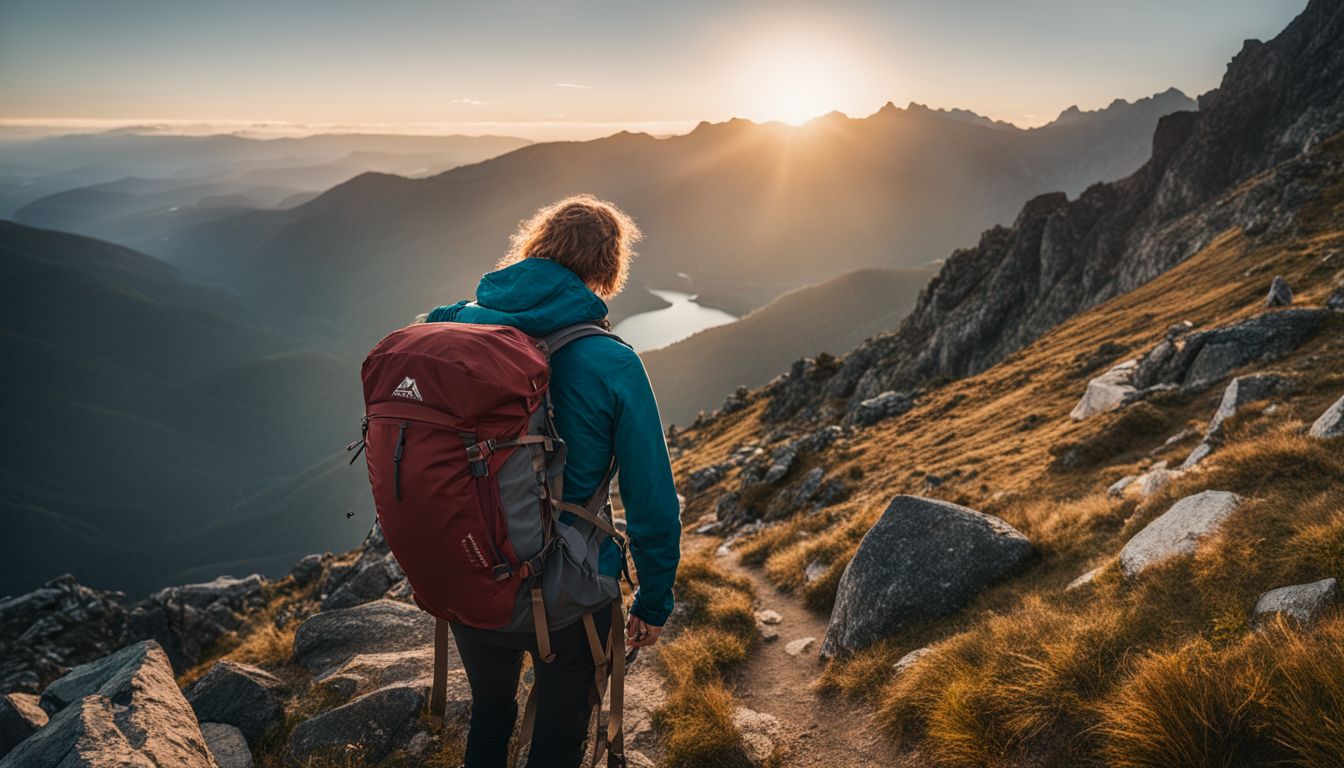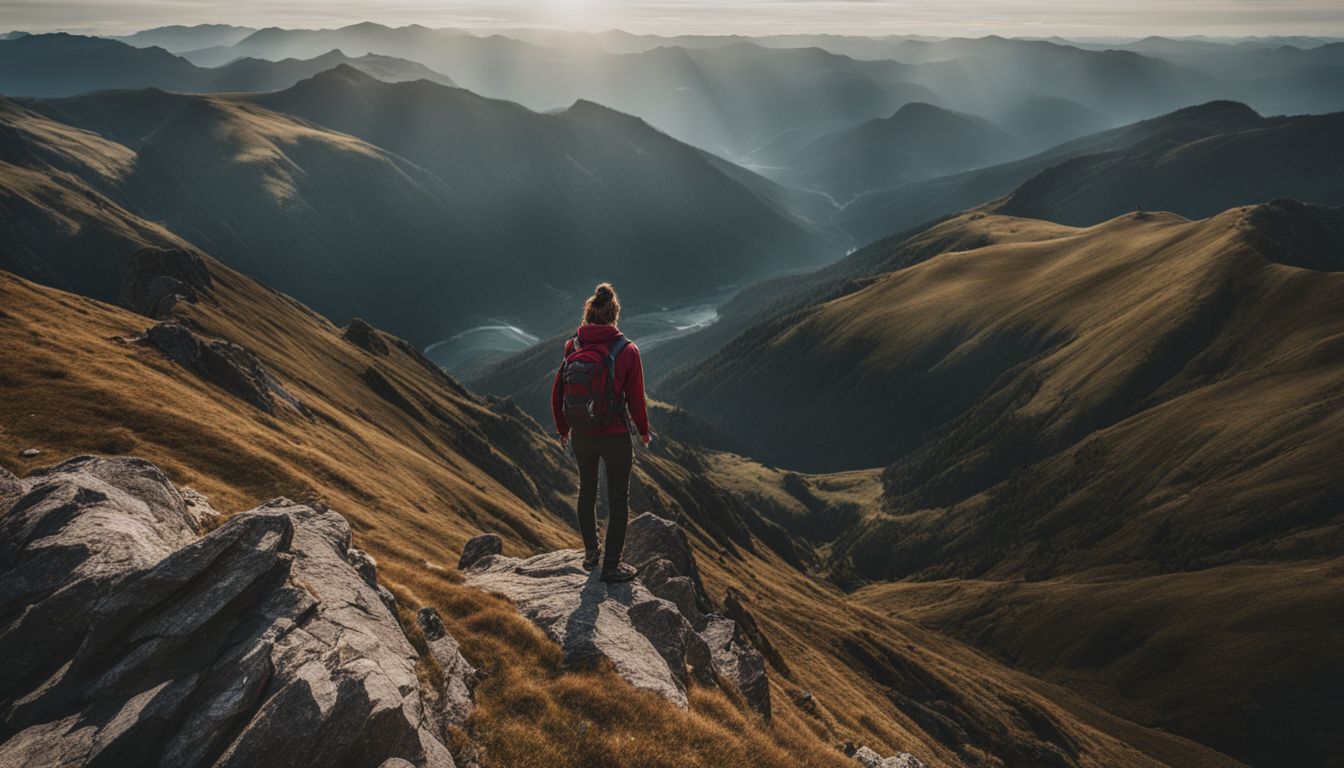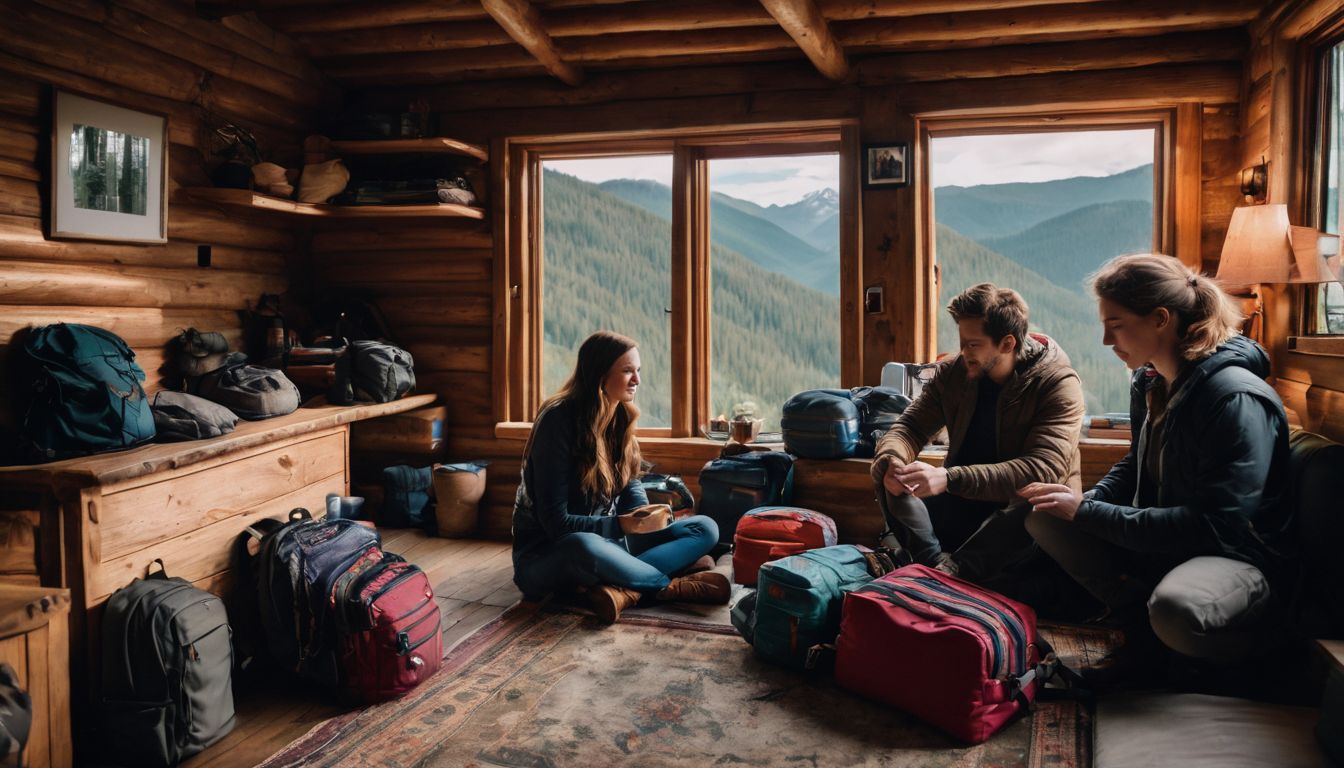Efficiently packing a rucksack for group travel isn’t just about saving space—it’s a fine art that can enhance your overall experience. Drawing from years of adventure and guiding group excursions, I’ve learned that the right strategy can turn a chaotic bag into an organized portable closet.
Harnessing the power of weight distribution, one must masterfully select each item to ensure comfort and convenience on the go.
To launch our journey toward rucksack mastery, let’s tackle the cornerstone lesson: every square inch is precious real estate. By choosing versatile clothing and utilizing travel-sized toiletries, day-to-day living out of a backpack becomes less hectic and more harmonious—a truth all seasoned travelers swear by.
Keep reading for insights that transform packing from daunting to expert-level easy. Let’s dive in!
Key Takeaways
- When choosing a rucksack for group trips, consider features like frame type, ventilation, padding, pockets, and access to ensure comfort and convenience.
- Plan your attire for functionality and versatility by selecting clothes that can be worn in different situations and adhere to a minimalist shoe policy to save space in your rucksack.
- Pack essential items for seasonal transitions such as layering clothing, compact rain jacket or windbreaker, warm hat and gloves, sunscreen, sunglasses, and additional items based on specific climate needs.
- Efficiently organize gear by packing essentials for group needs like a canister stove or first aid kit; utilize pockets and compartments efficiently.
Choosing the Right Rucksack

When it comes to selecting a rucksack for group trips, it’s crucial to consider the specific features that will suit your needs. From sternum straps for extra support to spacious compartments for organizing gear, picking the right bag can make all the difference in a successful trip.
Importance of picking a suitable bag
Picking the right rucksack is like choosing the best travel buddy. It needs to fit just right and be ready for anything. Think about your trip’s length and what you’ll do. A small bag might be fine for a short city break, but longer adventures or outdoor trips need more space.
Look for backpacks with adjustable straps and hip belts so you can carry it comfortably all day.
Your chosen ruck sack must have enough room but not too much, so you’re not tempted to over pack. Good bags come with different sections to keep things organized, like packing cubes for clothes or special pockets for your travel essentials.
Bags that are too big make moving around harder, especially if you plan on hopping from place to place.
Always check that your backpack has strong zippers and sturdy material—these things take a beating on the road! And don’t forget about comfort: padded shoulder straps save your muscles during long treks through new cities or nature trails.
Making the effort to choose carefully means less trouble later on, letting you focus on having fun with your group.
Features to consider
Choosing the right travel backpack makes your group trip smoother. Let’s dive into the important features to look for in a rucksack.
- Frame type: Get one with a strong frame if you’re carrying heavy loads. An internal frame is sleek and stable, but an external frame is good for bulky items.
- Ventilation: Look for a back panel with good airflow to keep you cool. Mesh panels can prevent your back from getting too sweaty on long hikes.
- Padding: Padded shoulder straps and hip belts help distribute weight evenly. This means less strain on your body during those long walks.
- Pockets: Multiple pockets make it easy to grab what you need fast. Side pockets are great for water bottles, while top pockets keep small items handy.
- Backpack access: Pick a backpack that opens from the top or front. This will help you find things without pulling everything out first.
- Removable day pack: For city exploring, having a smaller pack that zips off is super handy. You won’t need the whole bag every time you leave the hostel accommodations.
- Hydration compatibility: If you drink lots of water, get a backpack that fits a hydration bladder. It’s much easier than reaching for a bottle every time you’re thirsty.
- Sleeping bag compartment: A dedicated space for your sleeping bag keeps it dry and separate from other gear.
Essential Clothing Strategies

Plan your attire for functionality and versatility, ensuring that each item of clothing serves a purpose. Adhere to a minimalist shoe policy to save space in your rucksack and prioritize comfort during long walks or hikes.
Planning your attire for functionality and versatility
Packing the right clothes can make your group trip much better. Think about clothes that work well for different situations and are easy to mix.
- Choose clothes you can wear in many ways. This means shirts that look good on a hike or in a restaurant.
- Pick shirts with front pockets because they are useful and help you blend in.
- Take pants that zip off into shorts so you’re ready for any weather.
- Bring a sweatshirt that’s cozy for cool nights but also smart enough for city walks.
- Focus on clothes that don’t wrinkle, so you always look neat without ironing.
- Roll your clothes instead of folding them to save space and prevent creases.
- Stick to a few colors that all match so everything works together.
- Go for fabrics that dry fast so you can wash them easily if needed.
- Have one nicer outfit just in case there’s a special evening out.
- Remember the minimalist shoe rule: one pair for walking, one for water and flip-flops for showers.
Adhering to a minimalist shoe policy
Minimalist shoe packing is essential for efficient rucksack organization on group trips. By embracing this approach, travelers can bring versatile footwear that complements various outfits without overloading their bags.
This includes selecting shoes that are suitable for different activities and occasions, promoting practicality during the journey. Adhering to a minimalist shoe policy allows individuals to streamline their packing process and minimize unnecessary bulk in their rucksacks, enabling more space for other essentials while on the go.
Travelers can achieve a minimalist shoe policy by opting for multi-purpose footwear such as compact sneakers or sandals suitable for both casual strolls and light outdoor activities.
Rucksack Packing for Seasonal Transitions
Packing for seasonal transitions requires careful planning and consideration to ensure you have the right clothing and gear for varying weather conditions.
- Layering is essential for adapting to temperature changes, so pack lightweight and versatile clothing items that can be easily added or removed.
- Consider packing a compact rain jacket or windbreaker to stay dry and comfortable during unexpected weather shifts.
- Bring a warm hat and gloves for colder conditions, even if the destination is primarily warm, as nights can still be chilly in some locations.
- Don’t forget to pack sunscreen and sunglasses for protection against the sun, especially when transitioning from cooler to warmer climates.
- If traveling between different climate zones, include items such as a foldable umbrella or a compact travel blanket to accommodate various weather scenarios.
Organizing Your Gear
Organizing Your Gear involves packing essentials for group needs and utilizing pockets and compartments efficiently. Efficient organization can make a significant difference in the ease of your trip.
Packing essentials for group needs
When preparing for group trips, it’s essential to pack items that cater to the collective needs of the group. Here are the essential items to consider:
- Canister stove: A reliable cooking source for group meals, ensuring efficient meal preparation.
- Group first aid kit: A comprehensive medical kit to address any health-related concerns during the trip.
- Battery lantern: Provides illumination for group activities and enhances safety during nighttime.
Utilizing pockets and compartments efficiently
Pockets on a rucksack are valuable for keeping small items within reach without needing to remove the pack. Some packs have a separate sleeping bag compartment at the bottom, with a trap door to keep it isolated from dirty clothes and wet items. Detachable mesh pockets can be used to organize gear effectively and keep it accessible during hikes.
- Utilize exterior pockets for items such as water bottles, snacks, or a rain jacket.
- Keep frequently accessed items like maps, sunscreen, or sunglasses in easily reachable pockets.
- Use interior compartments for heavier items like camping cookware or electronics to maintain balance while hiking.
- Consider using compression straps or bungee cords across the outside of the pack for items like trekking poles or a rolled-up tent.
- Organize smaller essentials in zippered pouches to prevent them from getting lost inside the main compartments.
- Utilize hip belt pockets for storing small valuables such as keys, money, or your phone.
Toiletries and Miscellaneous Items
When packing toiletries, opt for travel-sized bottles to save space and minimize weight. Additionally, consider a compact toiletry bag with compartments to keep items organized and easily accessible on the go.
Compact toiletry packing
When packing toiletries for a group trip, it’s essential to aim for compact and efficient organization. A well-prepared toiletry kit can streamline your travel experience, providing convenience and ease. Here’s how to pack your toiletries effectively:
- Utilize travel-sized bottles: Opt for small, lightweight containers to minimize space while still meeting your needs for essential toiletries.
- Categorize items by use: Separate toiletries into clear, resealable bags according to function, such as skincare, haircare, and oral hygiene products to maintain organized packing.
- Multi-functional products: Choose items that serve multiple purposes if possible, reducing the number of individual products needed which is particularly helpful when traveling within a group.
- Consider the travel rules: Be aware of any restrictions on liquids or specific items imposed by transportation regulations to avoid any inconvenience during security checks.
- Incorporate a hanging toiletry bag: A convenient way to store and access your essentials while saving counter space in shared accommodations or while camping.
Miscellaneous items checklist
After organizing your toiletries efficiently, it’s crucial to have a well-thought-out checklist for miscellaneous items. Here’s a comprehensive list to ensure you’re fully prepared for your group trip:
- Dryer Sheets: Pack a few dryer sheets to keep your clothes smelling fresh throughout the trip.
- Vaseline: Besides its traditional use, Vaseline can also be used to prevent blisters or as a lip balm.
- Dental Floss: In addition to oral care, dental floss doubles as a strong and durable thread for emergency clothing repairs.
- Travel Sewing Kit: This compact kit should include needles, safety pins, and small scissors for quick fixes on the go.
- Multi-tool: A versatile tool with various functions can be handy in unexpected situations.
- Quick-Dry Towel: Opt for a lightweight and compact towel that dries quickly after use.
- Power Bank: Keep your devices charged during long days of exploration and activities.
- Ziplock Bags: These come in handy for storing snacks, electronic devices, or keeping wet items separate from dry ones.
- Earplugs and Eye Mask: Essential for getting restful sleep in noisy or bright environments while traveling.
- Reusable Water Bottle: Stay hydrated on the go while reducing plastic waste by using a refillable water bottle.
- Portable First-Aid Kit: Include basic medical supplies such as band-aids, antiseptic wipes, and pain relievers.
Conclusion
In conclusion, packing for group trips can be made easy with the right rucksack and strategies. The practical tips provided ensure efficient and organized packing for all seasons. Have you considered how these methods can simplify your next group adventure? Implementing these approaches will lead to smoother and more enjoyable travel experiences.
Explore further resources as you prepare for your upcoming group trip!
For more detailed tips on adapting your rucksack contents for varying weather conditions, check out our guide on packing for seasonal transitions.
FAQs
1. What is the best way to pack a rucksack for a group trip?
For group trips, rolling your clothes can save space in your rucksack. Also, using a minimalist packing style and picking items like flip flops and sleeping bags that are light makes carrying the bag easier.
2. Can I bring just one personal item in my hand luggage on a plane?
Yes, you usually can bring one personal item like a city-hopper backpack or small hand luggage on board with you during your flight.
3. Should I carry a laundry bag when traveling with friends?
Yes, bringing along a laundry bag helps keep dirty clothes separate from clean ones in your rucksack when traveling with others.
4. Are flip flops necessary for group travel?
Flip flops are easy to pack and great for shared showers or quick trips outside, so they’re smart to include in your rucksack for group travels.

